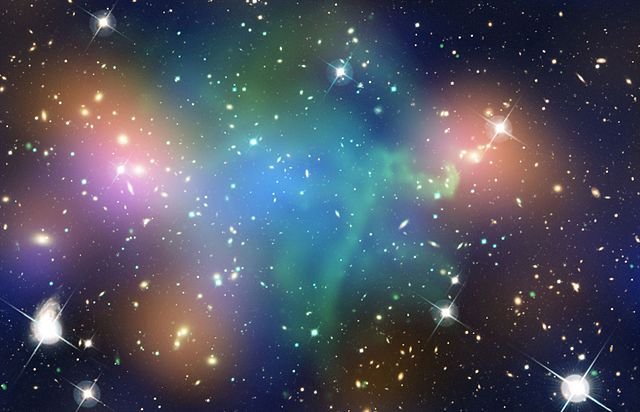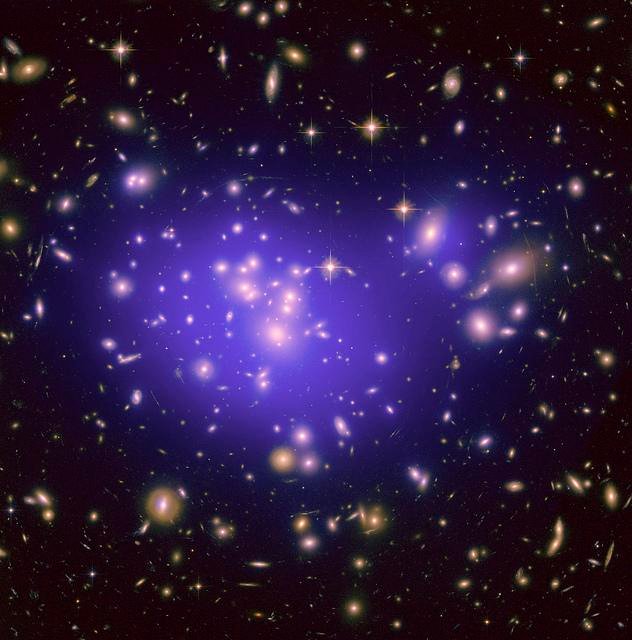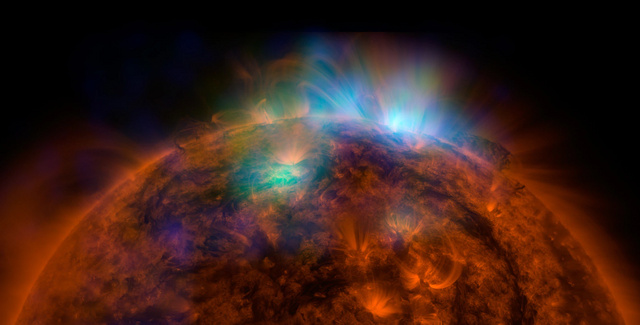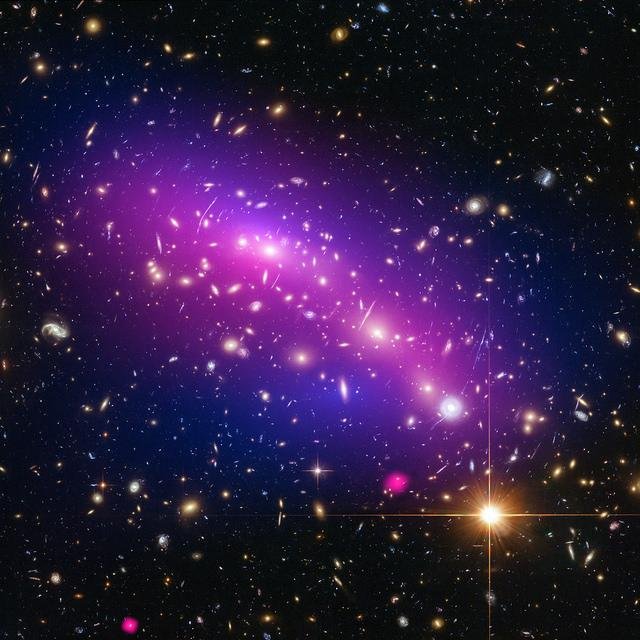Dark matter rising in the sun
A couple of weeks ago, a question was asked on StemQ, about dark matter and the option for very massive objects to contain some of it. I sketched a first answer last week, here, where I explained that this option is very valid. Furthermore, there is even some dark matter locally around us, close to Earth and in the sun.
 [image credits: Chandra @ NASA (public domain)]
[image credits: Chandra @ NASA (public domain)] In this post, I will move on on this topic and focus on the usage of the sun as a probe for dark matter.
This extends an older post of mine (available here) and actually provides more details on how dark matter behaves in the sun.
I will however first briefly summarize the basics about dark matter and how we can conclude that there is some of it around us (just in the aim of making this blog article self-consistent).
I will then move on with the description of what dark matter can do in the sun and how a specific class of dark matter models, where dark matter particles self-interact with each other at an important rate, can be constrained thanks to our good old closest star.
DARK MATTER 101
As I said it many times, dark matter is a very important topic in particle physics and astrophysics research. For this reason, a general summary of the motivations behind it is useful. I refer to my former post for more details.
 [image credits: NASA/ESA (CC BY 2.0)]
[image credits: NASA/ESA (CC BY 2.0)] Dark matter is a key component in Standard cosmology.
Whilst its nature is still totally unknown, assuming its presence helps to get a very good agreement between data and theory, at a level alternatives cannot get to.
One of the main motivations behind dark matter is that it allows us to understand the motion of stars within galaxies.
Some invisible mass (dark matter) must be added to get the observed motion of the stars matching the predictions.
However dark matter also allows to describe gravitational lensing correctly. The presence of dark matter indeed explains the observed bending of light when it gets to us. In addition, dark matter is also a key component to understand the small temperature variations in the cosmic microwave background, the fossil radiation left over from the big bang.
 [image credits: NASA/ESA (Public domain)]
[image credits: NASA/ESA (Public domain)] And very importantly, dark matter is necessary to explain galaxy formation.
Without dark matter, it would have been impossible for matter to form galaxies and galaxy clusters as observed today.
The results of the cosmological simulations are crystal clear with this respect.
These simulations furthermore also show that there is some dark matter around us, locally, including inside our good old sun.
The are about 1000 tons of dark matter in the sun, to be compared with the total mass of the sun of 2 x 1027 tons. A small number, but a number large enough to help physicists to understand dark matter better.
THE LIFE OF DARK MATTER IN THE SUN
The life of a dark matter particle entering either the sun, or Earth, or the solar system, is very easy to evaluate. Well maybe not that easy, but this is doable with the appropriate knowledge, as detailed here. Let us have a look on what could happen to a given dark particle entering the sun, Earth or any massive object.

[image credits: NASA]
First, it may happen that our dark matter particle hits an atomic nucleus belonging to the considered object.
It can then either be scattered and continue its route, or be captured inside it. This has a small chance to happen, as dark matter is very weakly interacting, but the chances are non zero.
If we integrate over the age of the solar system, we may thus really have a bunch of captured dark matter particles around here.
From there, captured dark matter can evaporate (or be ejected) by being hit by other nucleus (with some probabilities), or even annihilate when meeting another dark particle (with some probability again).
Finally, dark matter may also be self-interacting in some models. In this case, the self-interactions contribute to the above-mentioned capture and evaporation processes, and modify their dynamics.
All the necessary rates can be calculated once the model is fixed, so that the evolution of dark matter can be predicted. And predictions can always be confronted to data…
CONSTRAINING DARK MATTER WITH THE SUN AND EARTH
The crucial point in what has been said above is that the way in which dark matter interacts within the sun, Earth or a planet, leads to a modification in the fluxes of dark matter reaching Earth.
And this is a very good news, as we have a bunch of experiments trying to observe dark matter through its direct detection with atomic nuclei that are parts of the detector material.

[image credits: Smithsonian (public domain)]
In practice, one takes some large amount of a given material and puts cameras around it.
The interaction rate of dark matter with normal matter is tiny, so that considering big (actually very big) detectors is needed to maximize the chances of observing anything.
In general, dark matter particles do not interact with the detector and just go through it.
However, it happens that once in a while, with a very tiny rate, a dark matter particle hits an atomic nucleus from the detector material.
The recoil of the nucleus can be observed, and from the properties of this recoil, one can get back to what happened.
The current status is that dark matter direct detection experiments have not detected any sign of dark matter, so that constraints are put on the dark matter fluxes reaching the observatories on Earth or on the rate at which dark matter would interact with normal matter.
As dark-matter self-interactions modify this, the current null results offer a way to further constrain the nature of the self-interactions of dark matter. In other words, what is going on in the sun, Earth or any massive body of the solar system, allows us to learn more about what dark matter dynamics could be and could not be.
SUMMARY - TAKE-HOME MESSAGE
In this post, I first briefly review the motivations behind dark matter (motion of stars in galaxies, galaxy formation, the cosmic microwave background, etc.), which leads us to conclude that there were some dark matter in our solar system. As a second step, I detailed what could happen with this dark matter present in particular in the sun, Earth or any massive object. The interesting fact is that this could be useful for actual searches for dark matter.
A specific class of dark matter models, featuring self-interacting dark matter, leads to dark matter fluxes on Earth (resulting from what is going on inside Earth and the sun) that would challenge the current non-observations of anything. As a result, it turns out that dark matter self-interactions, even if very popular today, are more constrained than what we could naively think. Those conclusions stem from the dark matter dynamics inside the massive objects of our solar system that I have described in this post.
I recommend the reading of this recent paper appeared a couple of weeks ago where more details are provided.
STEEMSTEM
SteemSTEM aims to make Steem a better place for Science, Technology, Engineering and Mathematics (STEM). For more information about the SteemSTEM project, feel free to follow @steemstem, have a look to the last news from the project, check out our new app or read our latest distilled.
Please consider to support the project by voting for the SteemSTEM Witness (@stem.witness) or delegating to @steemstem for a ROI of 65% of our curation rewards (quick delegation links: 50SP | 100SP | 500SP | 1000SP | 5000SP | 10000SP).
We are on our way to make Steem a crucial medium for science communication, and it is still time to contribute to this effort!
I'm still wondering; if dark matter is around us, and maybe everywhere in the universe, and if they are the majority of the matter in the universe, why are scientists having a hard time discovering them?
An unrelated question here: Is dark energy a form of dark matter?
Dark matter is very illusive. To discover it, it needs to interact with the material making the detector. In the case of dark matter, the rate is very low so that even if there is some amount around us (that is not extremely large by the way, compared with the amount of matter), it is very rare to have even a single interaction with the detector.
No. They are two different entities. Dark energy is related to the expansion of the universe. You can see it as the engine behind the accelerated expansion of our universe. In contrast, dark matter is a form of matter.
i wonder what this dark matter are?
We wonder too. This is why we are actively searching for it, in the sense of direct detection.
Dark matter detection is a sneaky science :D
The Sun has got some of the interaction covered. Now, I see the work of the Sun in helping build a model. I'd like to ask if it is now a certain science that dark matter particles annihilate themselves.
As dark matter has to interact in some way (through gravity, or through potentially new forces), there will always be a possibility for it to interact and annihilate. Like electron-positron annihilation into photons, after replacing every involved particle by something dark.
Note that in the kind-of standard WIMP paradigm, dark matter particles will interact with some of the particles of the Standard Model (this could be one, 10, all, we don't really care). A consequence of these interactions are that:
That is the standard. However, there are ways to go beyond (secluded dark matter, strongly-interacting dark matter, etc.).
That answers my questions and more :)
It is a fascinating adventure whenever you wake up and go to work as a particle physicist :D
I like it every single day... except when it turns out I only do admin and no physics :/
Admin job seems monotonous and boring :)
Not monotonous, but I feel I would prefer to dedicate my time to something else :/
Another interesting post about this fascinating subject.
Thanks!
Thanks! This was the follow-up I promised to you :)
there's a dark matter rising in crypto markets ... it's called no bottom
There are dark days ahead, Mylord!
Very ahead.... hopefully, winter will have a definite length!
Definitely definite. While the length of winter for every person is very relative, it is thoroughly defined with a definite end!
Strangy enough that is called meteorological winter, even though weather has no influence on its length.
Global warming should be responsible... :D
Gravitational attraction in the bottom? :D
the forces at work in the crypto universe have not been able to be accurately accounted for !! (-:
Yeah, all my simulations break down :/
Congratulations @lemouth! You have completed the following achievement on the Steem blockchain and have been rewarded with new badge(s) :
Click here to view your Board of Honor
If you no longer want to receive notifications, reply to this comment with the word
STOPDo not miss the last post from @steemitboard:
Buen material @lemouth.
Thanks a lot!
Hi @lemouth!
Your post was upvoted by Utopian.io in cooperation with @steemstem - supporting knowledge, innovation and technological advancement on the Steem Blockchain.
Contribute to Open Source with utopian.io
Learn how to contribute on our website and join the new open source economy.
Want to chat? Join the Utopian Community on Discord https://discord.gg/h52nFrV